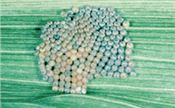Suspected Western Bean Cutworm Egg Mass Found

Figure 1. Larvae hatching form the suspected egg mass. Note dark unhatched eggs and partially
eaten shells of the hatched eggs.
Photo courtesy: Frank Peairs, Colorado State University, Bugwood.org
DR. RIC BESSIN
LEXINGTON, KY.
This week, a suspicious egg mass was found in a Daviess County corn field by a consultant who was scouting the field. The tentative identification of the egg mass is western bean cutworm (WBC), a pest of corn and garden beans that has not been previously found in Kentucky. The egg mass was distinctive because it was found on a upper leaf surface and resembles a large WBC egg mass. The eggs are just hatching, and they will need to be reared to a larger instar to properly identify the species. As we learn more, additional information will be forthcoming. The remainder of this article includes some basics on WBC.
Western bean cutworm is a serious pest of field corn in states to our north and west. In recent years it has expanded from its historical geographic range of Nebraska, Colorado, and Wyoming and moved eastward across much of the Corn Belt. We have been fortunate that this expansion has been to our north. After hatching, larvae initially feed on pollen and anthers, then move to the ear zone, concentrating their feeding on developing kernels. They enter the ear either through the silk channel or side of the ear. Unlike corn earworm, which is cannibalistic and limits the number of larvae per ear, there may be several WBC larvae per ear. Studies have shown that an average of one larva per plant can reduce yields by 3.7 bushels per acre and extreme infestations can lead to losses of 30 percent to 40 percent.
Scouting
Persons scouting WBC need to look for the eggs in masses of up to 200 eggs on the upper surfaces of newly unfolded leaves of corn that is soon to tassel or is tasseling. The spherical eggs (Figure 1) are initially white, then darken to tan and pink and are purple just before larvae hatch 5 to 7 days after oviposition. Larvae, which are dark with black heads, consume the egg shells after emergence, so egg masses are difficult to find after hatch.
Management
WBC is not adequately controlled by many of the Bt traits. Corn with the Vip3A gene, also known as Viptera, provides the best WBC control. As with other pests that feed in protected places on the corn plant, timing of foliar insecticides is critical to catch the larvae before they enter the ear. ∆
DR. RIC BESSIN: Extension Entomologist, University of Kentucky